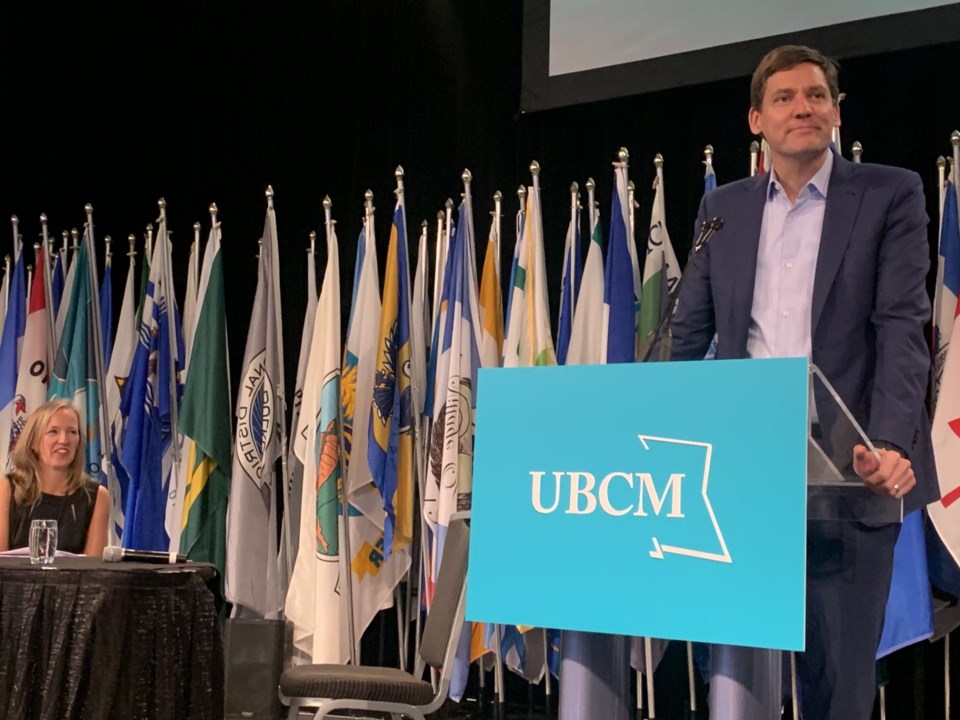When Premier David Eby was a drug prosecutor in Vancouver, many years ago, one case that involved prosecuting a young Indigenous woman who was addicted to crack cocaine shaped his view of drug decriminalization, he said in a speech last week in Vancouver at the Union of B.C. Municipalities convention.
“I came from a background of going into the law to try to make a difference in the world trying to make things better,” Eby said. “And suddenly, I found myself cross examining a woman who's in tears, who had none of the advantages that I had growing up. I was deploying every advantage I had been given to try to put her in jail.”
Her addiction caused her illegal actions – she went somewhere she was barred from going – but still everyone in the room was focused on punishing her rather than getting her help. Everyone in the room was a paid employee, from the lawyers to the guards, except the woman herself. She was found guilty, but walked away worse than when she came into the courtroom because she was less trusting of authority and government, Eby said.
“The experience was surely so traumatic for her. It was traumatic for me, (and) there wasn’t even any threat of (me) going to jail,” he said. “There's the ability to address those kinds of situations in a more compassionate way to get people treatment (and) to intervene in their lives to get them back on the right track.
“That is what we're trying to do. That is what decriminalization is about – to get a doctor or a nurse between a predatory drug dealer and somebody struggling with addiction.”
Nearly 13,000 people have died in B.C. from toxic drugs since the public health emergency was declared in 2016. In August alone, 174 people died, a number Lisa Lapointe, chief coroner for B.C. called “heartbreaking.” Unregulated drug toxicity is the leading cause of death in British Columbia for persons aged 10 to 59, accounting for more deaths than homicides, suicides, accidents and natural diseases combined, Lapointe reported.
B.C. is the first province in Canada to decriminalize drugs and the first to offer a prescribed safer supply of drugs to those who are already addicted.
Those processes, while groundbreaking, honourable and lifesaving, are not without growing pains. For instance, earlier this month, a doctor from Victoria, Mark Mallet, wrote in the Globe and Mail that some of that prescribed safe supply is ending up being sold to teenagers in the form of “Dillies” – pills that come in a drug store blister pack, are cheap and may appear safe. But those pills are hydromorphone, sold under the name Dilaudid. Mallet’s very compelling article says some of those teenagers end up addicted to opioids and eventually overdose from illicit drugs laced with fentanyl.
Lapointe addressed this concern, in part, in her report, saying that hydromorphone has been detected in three per cent of expedited toxicological testing this year, while illicit fentanyl has been found in 85 per cent of such tests. She also noted that most hydromorphone prescriptions in B.C. are for pain relief, not safer supply.
Even so, if these prescribed pills are a pathway to opioid addiction, the process of giving people prescription opioids to take home should be revisited and improved, to ensure none of these prescriptions end up being resold. Parents should also educate their children that “Dillies” are highly addictive opioids.
Another interesting piece of information in Lapointe’s report is that in two-thirds of drug deaths in B.C., smoking was the mode of consumption. I had assumed injection rather than smoking would be behind most deaths.
Eby was questioned at the UBCM about the availability of treatment beds. He said the biggest challenge is finding enough psychiatric nurses, psychiatrists and addiction doctors to staff addiction treatment beds.
“The whole idea of harm reduction is to keep people alive, to make sure that they're not sick, and that they're able to benefit from treatment when they're at that place,” Eby said. “We need to have those beds available, and they could be mental health beds and they could be addiction beds. And that's a huge focus of mine … and we're going to do it.”
The more treatment beds, the better. The safer the supply, the better. Some might think the Dilly issue is a reason to stop the entire safe supply program, but I would argue it’s a reason to take a second look and tweak the program so that none of that safe supply ends up in the hands of anyone who isn’t already addicted to drugs. Surely we can figure that out.
Tracy Sherlock is a freelance journalist who writes about education and social issues. Read her blog or email her [email protected].



